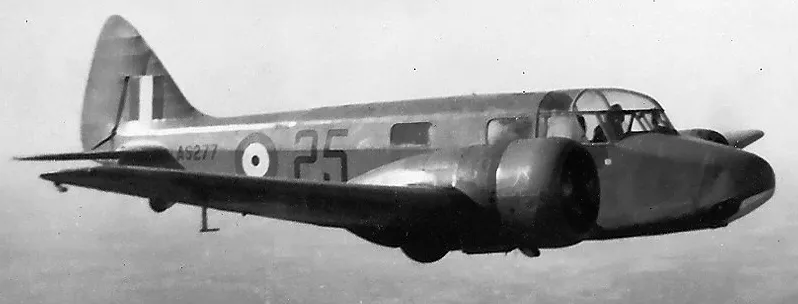Airspeed Oxford

Airspeed A.S. 10 Oxford Mk. II, RCAF (Serial No. AS277), 25, in flight over Saskatchewan, 1942.
The Airspeed AS.10 Oxford was a twin-engine monoplane aircraft developed and manufactured by Airspeed. It saw widespread use for training British Commonwealth aircrews in navigation, radio-operating, bombing and gunnery roles throughout the Second World War.
The Oxford was developed by Airspeed during the 1930s in response to a requirement for a capable trainer aircraft that conformed with Specification T.23/36, which had been issued by the British Air Ministry. Its basic design is derived from the company's earlier AS.6 Envoy, a commercial passenger aircraft. Performing its maiden flight on 19 June 1937, it was quickly put into production as part of a rapid expansion of the Royal Air Force (RAF) in anticipation of a large-scale conflict.
As a consequence of the outbreak of war, many thousands of Oxfords were ordered by Britain and its allies, including Australia, Canada, France, New Zealand, Poland, and the United States. Following the end of the conflict, the Oxford continued to achieve export sales for some time, equipping the newly formed air forces of Egypt, India, Israel, and Yugoslavia. It was considered to be a capable trainer aircraft throughout the conflict, as well as being used a general-purpose type. A large number of Oxfords have been preserved on static display. Wikipedia
CASPIR Aircraft Groups:
RCAF On Strength (821), Canadian Aircraft Losses (168)Oxford Mk. I AT460
Used by No. 35 Service Flying Training School at North Battleford, Saskatchewan. Category C4 damage at 00:30 on 30 April 1942 (or 1943?), when a tire burst on landing at North Battleford and the starboard undercarriage collapsed. No injuries. Category A crash on 5 July 1943. Crashed into a hillside near Prongua, Saskatchewan at 08:15, after striking a tree during unauthorized low flying. Part of the starboard wing was severed, the aircraft rolled over and flew into a nearby hill. Totally destroyed by post impact fire. The RAF instructor pilot had dinner the previous night at a farm house near the accident scene. Sgt. Laurence Stanley HODGKINS, RAF 1353529 and LAC Thomas ROBINSON, RAF 1670056 killed.
1941-09-19 Taken on Strength 2019-08-20
1943-April-26 Accident: 35 Service Flying Training School Loc: Aerodrome Names: Cook | Marshall
1943-July-05 Accident: 35 Service Flying Training School Loc: Prongua Saskatchewan Names: Hodgkins | Robinson
1943-08-23 Struck off Strength 2019-08-20





 Commonwealth War Graves Commission
Commonwealth War Graves Commission Find-A-Grave.com
Find-A-Grave.com Library and Archives Canada Service Files (may not exist)
Library and Archives Canada Service Files (may not exist) North Battleford City Cemetery, Canada
North Battleford City Cemetery, Canada Oxford Trainer
Oxford Trainer Wikipedia Oxford Trainer
Wikipedia Oxford Trainer Harold A Skaarup Web Page
Harold A Skaarup Web Page
 RCAF.Info - RCAF Station North Battleford SK
RCAF.Info - RCAF Station North Battleford SK Saskatchewan Virtual War Memorial - Base History
Saskatchewan Virtual War Memorial - Base History